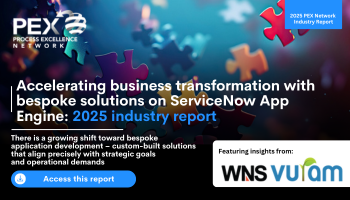Process excellence 101: Using the benefit-effort RACIT Matrix
But how do you ensure that improvement steps are implemented to create tangible gains for your organization? One way is to plot a benefit-effort RACIT Matrix.
Add bookmarkYou have gone through the Define, Measure and Analyze phases in a Six Sigma project. There have been collective "aha" moments during the brainstorm and feedback sessions of your team. You have also taken the next step to identify the causes of the opportunities that you see and identify the steps necessary to achieve the improvement being addressed.
But how do you, as a project leader, ensure that the Improvement steps are implemented to transform all that brain work into tangible gains for your organization? One way is to plot a benefit-effort RACIT Matrix.
Join the PEX Network community

Don't miss any news, updates or insider tips from PEX Network by getting them delivered to your inbox. Sign up to our newsletter and join our community of experts.
Learn MoreWhat is a benefit-effort-RACIT matrix?
A benefit-effort RACIT matrix can be best defined as a graph that first of all details the benefit a potential initiative can bring versus the effort in terms of time and resources required with the addition of a project timeline, including Start and End Dates.
RACIT stands for Responsible, Accountable, Consulted, Informed, Time-line.
This should be nothing new to any of the process improvement practitioners out there, but I had to share how I have found this format working towards a successful implementation.
STEP 1: Create your benefit-effort matrix
After identifying all your Improvement steps, the next step is to go through each and every action item and assign High OR Medium OR Low for Benefit and Effort. This can be done on a spreadsheet and this will enable the use of "Auto Filter" that may be of value if there is a big list .
The Action items for Phase 1 implementation can be done in the following order:
1. High Benefit and Low Effort
2. Medium Benefit and Low Effort
3. High benefit and Medium Effort
NOTE: Some Low Benefit and Low effort items should also be considered as they may have incremental additions to efficiency which may not be immediately visible.
Action items that can come in Phase 2 of Implementation or may be re-evaluated:
1. High Benefit and High Effort.
2. Medium Benefit and Medium Effort.
The other types can be reviewed if the Benefit/Effort classification has been made correctly and unless the Benefit Effort criteria meets Phase 1 or 2 above it probably can be left alone for the time being.
STEP 2: Assign human resources to the implementation
The addition of a Start and End date to each of the action items that has been chosen to be worked on (Phase 1 and Phase 2) is very critical to ensure successful on-time completion.
Practitioners will know that it is essential to have only one name assigned for Accountable. If there are multiple names there is opportunity for the ball to be dropped. If a similar action item is being carried out in different business units it is best to have two line Items and have one person "Accountable".
Some caveats in this process:
1. This activity needs to be done as a team.
2. Process owners and users impacted by the change should have a buy in to the Action item.
3. The time gap in Start and End date should never not exceed 2 months if it is a Low effort and 3 months for Medium Effort.
4. Track progress on a Bi-monthly basis or monthly basis. This is assuming that this is not the only project the resources will be working on. This is more then likely going to be an addition.
A sample spreadsheet template is shown below:
|
No. |
ACTION |
BENEFIT |
EFFORT |
RESPONSIBLE |
ACCOUNTABLE |
CONSULTED |
INFORMED |
START DATE |
END DATE |
|
1 |
Project A |
High |
Low |
Process Owners |
Project Lead |
Process Support Staff |
Sponsor |
|
|
|
2 |
Project B |
Medium |
Medium |
Process Owners |
Project Lead |
Process Support Staff |
Sponsor |
|
|
|
3 |
Project C |
Medium |
Low |
Process Owners |
Project Lead |
Process Support Staff |
Sponsor |
|
|
|
4 |
Project D |
Low |
High |
Process Owners |
Project Lead |
Process Support Staff |
Sponsor |
|
|
|
5 |
Project E |
High |
High |
Process Owners |
Project Lead |
Process Support Staff |
Sponsor |
|
|
|
6 |
Project F |
Medium |
Medium |
Process Owners |
Project Lead |
Process Support Staff |
Sponsor |
|
|
I hope this write up helps you in your process improvement Implementation endeavors and I look forward to hearing your comments, feedback, improvement ideas and experiences.
Accelerating business transformation with bespoke solutions on ServiceNow App Engine

Today, off-the-shelf software solutions offer diverse features that enable vast opportunities to implement and maintain business transformation. However, in some circumstances, capabilities lack the flexibility and specificity required to address the unique challenges and workflows of individual organizations. As a result, there is a growing shift toward bespoke application development – custom-built solutions that align precisely with strategic goals and operational demands.
Download this report to explore how enterprises can harness the power of custom applications to drive meaningful transformation. With the growing adoption of low-code platforms like ServiceNow App Engine, organizations are building custom applications faster and with greater control. By empowering both IT professionals and citizen developers to build tailored solutions, organizations can significantly reduce time to value while maintaining control over quality and compliance.
Download Now
